What Is A Wormhole?
What is a Wormhole?
Wormholes were first theorized in 1916, though that wasn’t what they were called at the time. While reviewing another physicist’s solution to the equations in Albert Einstein’s theory of general relativity, Austrian physicist Ludwig Flamm realized another solution was possible. He described a “white hole,” a theoretical time reversal of a black hole. Entrances to both black and white holes could be connected by a space-time conduit.

In 1935, Einstein and physicist Nathan Rosen used the theory of general relativity to elaborate on the idea, proposing the existence of “bridges” through space-time. These bridges connect two different points in space-time, theoretically creating a shortcut that could reduce travel time and distance. The shortcuts came to be called Einstein-Rosen bridges, or wormholes.

Certain solutions of general relativity allow for the existence of wormholes where the mouth of each is a black hole. However, a naturally occurring black hole, formed by the collapse of a dying star, does not by itself create a wormhole.
Wormholes are consistent with the general theory of relativity, but whether wormholes actually exist remains to be seen.

A wormhole could connect extremely long distances such as a billion light years or more, short distances such as a few meters, different universes, or different points in time
For a simplified notion of a wormhole, space can be visualized as a two-dimensional (2D) surface. In this case, a wormhole would appear as a hole in that surface, lead into a 3D tube (the inside surface of a cylinder), then re-emerge at another location on the 2D surface with a hole similar to the entrance. An actual wormhole would be analogous to this, but with the spatial dimensions raised by one. For example, instead of circular holes on a 2D plane, the entry and exit points could be visualized as spheres in 3D space.

Science fiction is filled with tales of traveling through wormholes. But the reality of such travel is more complicated, and not just because we’ve yet to spot one.

The first problem is size. Primordial wormholes are predicted to exist on microscopic levels, about 10–33 centimeters. However, as the universe expands, it is possible that some may have been stretched to larger sizes.
Another problem comes from stability. The predicted Einstein-Rosen wormholes would be useless for travel because they collapse quickly.

“You would need some very exotic type of matter in order to stabilize a wormhole,” said Hsu, “and it’s not clear whether such matter exists in the universe.”
But more recent research found that a wormhole containing “exotic” matter could stay open and unchanging for longer periods of time.

Exotic matter, which should not be confused with dark matter or antimatter, contains negative energy density and a large negative pressure. Such matter has only been seen in the behavior of certain vacuum states as part of quantum field theory.
If a wormhole contained sufficient exotic matter, whether naturally occurring or artificially added, it could theoretically be used as a method of sending information or travelers through space. Unfortunately, human journeys through the space tunnels may be challenging.

Wormholes may not only connect two separate regions within the universe, they could also connect two different universes. Similarly, some scientists have conjectured that if one mouth of a wormhole is moved in a specific manner, it could allow for time travel.

Although adding exotic matter to a wormhole might stabilize it to the point that human passengers could travel safely through it, there is still the possibility that the addition of “regular” matter would be sufficient to destabilize the portal.
Today’s technology is insufficient to enlarge or stabilize wormholes, even if they could be found. However, scientists continue to explore the concept as a method of space travel with the hope that technology will eventually be able to utilize them.
source
source
images: x, x, x, x, x, x, x, x, x
More Posts from Monstrous-mind and Others
🔭🌃🌌

Kepler-186f is the first Earth-sized planet ever found that also orbits in its star’s habitable zone. Although its size and orbit are known, its mass and composition are not - however, existing models suggest that it could have a rocky terrain and an atmosphere, making it potentially the most Earth-like planet discovered so far.
🐈🌃🌌


(via 500px / …… by Fabrizio Riccardo Castorina)

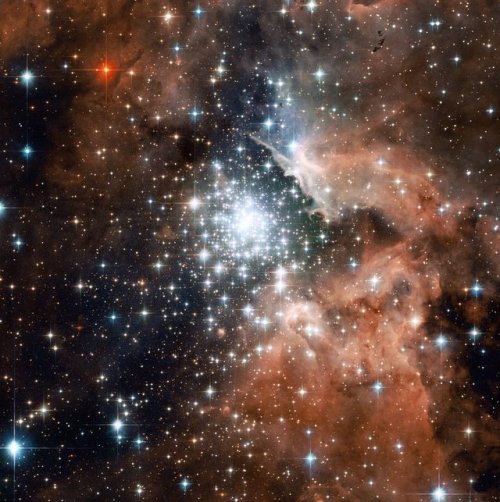
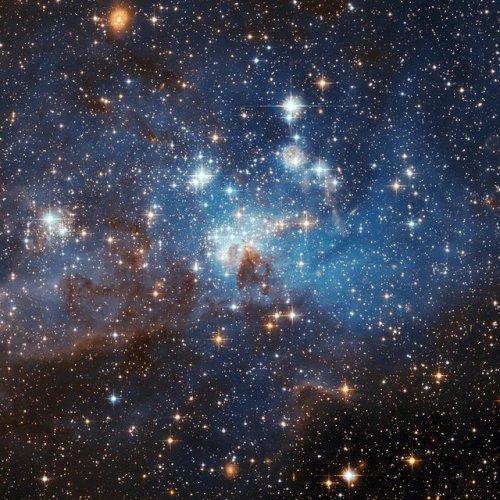
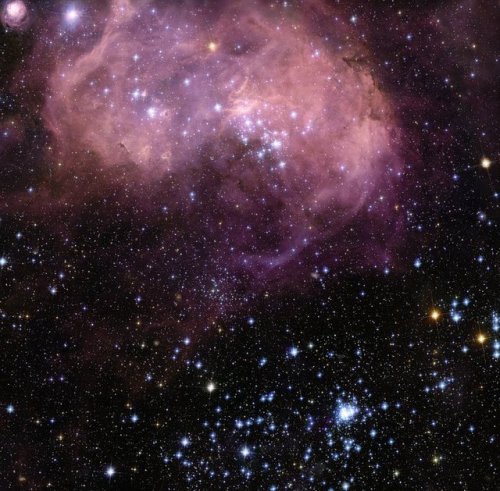
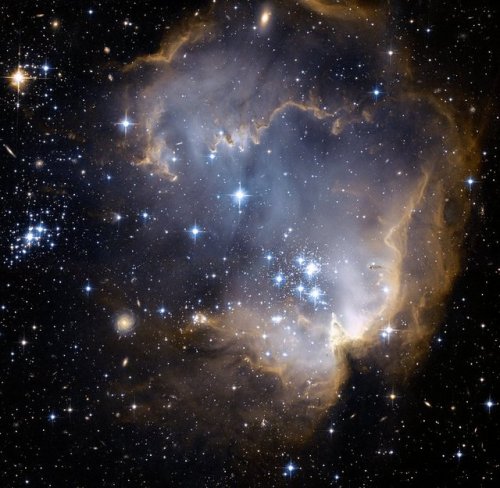
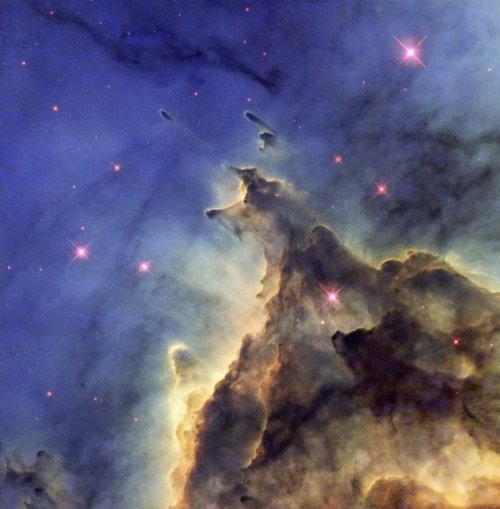
Star-forming regions amid gas and dust taken by the Hubble Space Telescope. (NGC 2467, NGC 3603, Star forming region in the Large Magellanic Cloud (LMC), N11, N90 and NGC 2174)
Image credit: NASA/ESA & Hubble
🍁🍂🎃


This photo of Comet Leonard was taken from a remote facility in Namibia.
SpaceWeatherGallery.com/Lukas Demetz / Michael Jaeger

Massive stars end their lives with a bang: exploding as spectacular supernovas, they release huge amounts of mass and energy into space. These explosions sweep up any surrounding material, creating bubble remnants that expand into interstellar space. At the heart of bubbles like these are small, dense neutron stars or black holes, the remains of what once shone brightly as a star.
Credit: ESA/XMM-Newton/ L. Oskinova/M. Guerrero; CTIO/R. Gruendl/Y.H. Chu

Black Holes Dine on Stellar Treats!

See that tiny blob of light, circled in red? Doesn’t look like much, does it? But that blob represents a feast big enough to feed a black hole around 30 million times the mass of our Sun! Scientists call these kinds of stellar meals tidal disruption events, and they’re some of the most dramatic happenings in the cosmos.

Sometimes, an unlucky star strays too close to a black hole. The black hole’s gravity pulls on the star, causing it to stretch in one direction and squeeze in another. Then the star pulls apart into a stream of gas. This is a tidal disruption event. (If you’re worried about this happening to our Sun – don’t. The nearest black hole we know about is over 1,000 light-years away. And black holes aren’t wild space vacuums. They don’t go zipping around sucking up random stars and planets. So we’re pretty safe from tidal disruption events!)

The trailing part of the stream gets flung out of the system. The rest of the gas loops back around the black hole, forming a disk. The material circling in the disk slowly drifts inward toward the black hole’s event horizon, the point at which nothing – not even light – can escape. The black hole consumes the gas and dust in its disk over many years.

Sometimes the black hole only munches on a passing star – we call this a partial tidal disruption event. The star loses some of its gas, but its own gravity pulls it back into shape before it passes the black hole again. Eventually, the black hole will have nibbled away enough material that the star can’t reform and gets destroyed.

We study tidal disruptions, both the full feasts and the partial snacks, using many kinds of telescopes. Usually, these events are spotted by ground-based telescopes like the Zwicky Transient Facility and the All-Sky Automated Survey for Supernovae network.

They alert other ground- and space-based telescopes – like our Neil Gehrels Swift Observatory (illustrated above) and the European Space Agency’s XMM-Newton – to follow up and collect more data using different wavelengths, from visible light to X-rays. Even our planet-hunting Transiting Exoplanet Survey Satellite has observed a few of these destructive wonders!
We’re also studying disruptions using multimessenger astronomy, where scientists use the information carried by light, particles, and space-time ripples to learn more about cosmic objects and occurrences.

But tidal disruptions are super rare. They only happen once every 10,000 to 100,000 years in a galaxy the size of our own Milky Way. Astronomers have only observed a few dozen events so far. By comparison, supernovae – the explosive deaths of stars – happen every 100 years or so in a galaxy like ours.
That’s why scientists make their own tidal disruptions using supercomputers, like the ones shown in the video here. Supercomputers allow researchers to build realistic models of stars. They can also include all of the physical effects they’d experience whipping ‘round a black hole, even those from Einstein’s theory of general relativity. They can alter features like how close the stars get and how massive the black holes are to see how it affects what happens to the stars. These simulations will help astronomers build better pictures of the events they observe in the night sky.
Keep up with what’s happening in the universe and how we study it by following NASA Universe on Twitter and Facebook.
Make sure to follow us on Tumblr for your regular dose of space!
😮💨📖📚📘📙📗

kitchen ghosts
-
 gregorlenko liked this · 1 year ago
gregorlenko liked this · 1 year ago -
 rank-sentimentalist reblogged this · 1 year ago
rank-sentimentalist reblogged this · 1 year ago -
 rank-sentimentalist liked this · 1 year ago
rank-sentimentalist liked this · 1 year ago -
 quinlovelia liked this · 1 year ago
quinlovelia liked this · 1 year ago -
 viladis1971 liked this · 1 year ago
viladis1971 liked this · 1 year ago -
 magickalchaos reblogged this · 1 year ago
magickalchaos reblogged this · 1 year ago -
 stuffandparables reblogged this · 1 year ago
stuffandparables reblogged this · 1 year ago -
 vocatuselixir liked this · 1 year ago
vocatuselixir liked this · 1 year ago -
 maroonpurpleprince liked this · 1 year ago
maroonpurpleprince liked this · 1 year ago -
 saturniinne liked this · 1 year ago
saturniinne liked this · 1 year ago -
 bastardsaint reblogged this · 1 year ago
bastardsaint reblogged this · 1 year ago -
 eyomarax reblogged this · 1 year ago
eyomarax reblogged this · 1 year ago -
 1-universe-1-spirit-1 reblogged this · 1 year ago
1-universe-1-spirit-1 reblogged this · 1 year ago -
 septimaseverina reblogged this · 1 year ago
septimaseverina reblogged this · 1 year ago -
 beefyfurrystuff liked this · 2 years ago
beefyfurrystuff liked this · 2 years ago -
 carefreemelon liked this · 2 years ago
carefreemelon liked this · 2 years ago -
 xploseof reblogged this · 2 years ago
xploseof reblogged this · 2 years ago -
 legally-a-bastard reblogged this · 2 years ago
legally-a-bastard reblogged this · 2 years ago -
 josephaudreleroix liked this · 2 years ago
josephaudreleroix liked this · 2 years ago -
 draemun reblogged this · 2 years ago
draemun reblogged this · 2 years ago -
 draemun liked this · 2 years ago
draemun liked this · 2 years ago -
 jazzietu reblogged this · 2 years ago
jazzietu reblogged this · 2 years ago -
 misantropagentile liked this · 2 years ago
misantropagentile liked this · 2 years ago -
 clown-alley-dot-com liked this · 2 years ago
clown-alley-dot-com liked this · 2 years ago -
 willbdeactivatingsoon liked this · 2 years ago
willbdeactivatingsoon liked this · 2 years ago -
 yourtoradorasextendedwarranty liked this · 2 years ago
yourtoradorasextendedwarranty liked this · 2 years ago -
 elpis-muse liked this · 2 years ago
elpis-muse liked this · 2 years ago -
 goethefaustworld liked this · 2 years ago
goethefaustworld liked this · 2 years ago -
 snickerslizard liked this · 2 years ago
snickerslizard liked this · 2 years ago -
 kaseycryptid-reactivated39253199 liked this · 2 years ago
kaseycryptid-reactivated39253199 liked this · 2 years ago -
 socoperspective liked this · 2 years ago
socoperspective liked this · 2 years ago -
 wanderer001 reblogged this · 2 years ago
wanderer001 reblogged this · 2 years ago -
 wanderer001 liked this · 2 years ago
wanderer001 liked this · 2 years ago -
 labseraph liked this · 2 years ago
labseraph liked this · 2 years ago -
 toastedphantom liked this · 2 years ago
toastedphantom liked this · 2 years ago -
 askmarietheapprentice reblogged this · 2 years ago
askmarietheapprentice reblogged this · 2 years ago -
 beardedmrbean reblogged this · 2 years ago
beardedmrbean reblogged this · 2 years ago -
 cyberpunkessence2 liked this · 2 years ago
cyberpunkessence2 liked this · 2 years ago -
 andthenthereweren0n3 liked this · 2 years ago
andthenthereweren0n3 liked this · 2 years ago -
 macafeenix liked this · 2 years ago
macafeenix liked this · 2 years ago
My ambition is handicapped by laziness. -C. Bukowski Me gustan las personas desesperadas con mentes rotas y destinos rotos. Están llenos de sorpresas y explosiones. -C. Bukowski. I love cats. Born in the early 80's, raised in the 90's. I like Nature, Autumn, books, landscapes, cold days, cloudy Windy days, space, Science, Paleontology, Biology, Astronomy, History, Social Sciences, Drawing, spending the night watching at the stars, Rick & Morty. I'm a lazy ass.
222 posts